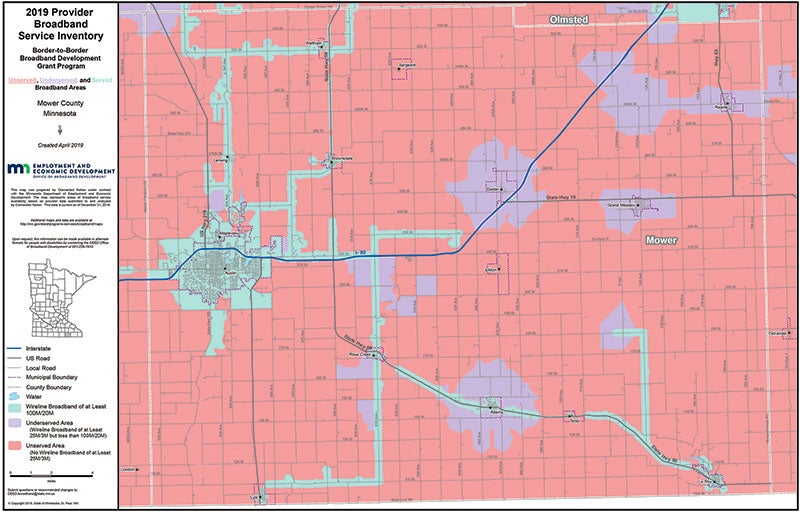Bridging the digital divide in rural Mower County
Published 5:41 am Friday, August 30, 2019

- This map shows the amount of area in Mower County that is either unserved or underserved in terms of broadand internet in comparison to those areas that are served. Provided by Minnesota Employment and Economic Development
For those living in rural Mower County, high-speed internet may be closer to reality.
The Mid Continent Communication (MIDCO) based in Sioux Falls, South Dakota, requested a resolution and letter of support from Mower County after being provisionally awarded $38.9 million in Connect America Fund (CAF) Phase II funding through the Federal Communications Commission to provide high-speed internet access to 9,371 places using optical fiber and terrestrial fixed wireless assets.
On Tuesday, the Mower County Board unanimously approved to pass a resolution and support MIDCO after the organization received $38.9 million in Connect America Fund (CAF) Phase II funding from the Federal Communications Commission to provide high-speed internet access to 9,371 places in rural Mower County by using optical fiber and terrestrial fixed wireless assets.
Harren stated that the Phase II support recipients must offer commercially at least one voice and one broadband service meeting the relevant service requirements to the required number of locations in the following time frame:
— 40 percent of the required number of places in Minnesota by the end of the third year of support
— An additional 20 percent in each subsequent year
— 100 percent by the end of the sixth year of support
—The exact deployment schedule is determined by the carriers themselves and not the FCC.
Also, the recipients have to file with Universal Service Administrative Company yearly reports and built-out milestone certifications and data on the locations where service is available. Failure to meet these terms of support can result in increased reporting requirements as well as possibly withholding support.
Much of Mower County remains underserved or not served at all by high-speed internet. It is apparent that outside the city limits in Austin, much of the sparsely populated communities in surrounding townships and communities are barely receiving, or not receiving, internet services.
Harren knows the reality of how important having rural broadband is for a small town. Having served in rural Itasca County, in northern Minnesota, Harren saw that the lack of high-speed internet saw businesses suffer and the real estate market take a significant hit. In a town where recreational tourism is the main draw, having internet was crucial to maintain the local economy.
“Fixed assets weren’t an option back then,” she said. “Tech wasn’t as advanced back then as it is now. We couldn’t go through trees since Itasca dealt mostly with forestry. It’s much easier to implement this in Mower County.”
Although there weren’t specific percentages as to how much of Mower County remains underserved or unserved entirely, Harren said that the high cost often deterred providers from extending services to areas where populations were more sparse.
“The agricultural areas have sparse populations that would not support the expense of a fiber build out there because there are not enough users,” Harren said. “We have a lot of geography that is completely unserved with sparse population due to our ag industry. We also have a large underserved geography. Without Minnesota Broadband and the FCC doing this type of funding, it would not be financially feasible in rural areas. It takes a MIDCO grant to make this possible.”
Currently, MIDCO is working on an application for Minnesota Broadband funds that would permit them to build out broadband in unserved or underserved areas in rural Minnesota by working with six counties and submit their grant with either five or six projects.
Mower County was chosen as one of the six counties to be eligible for a grant between $300,000 to $500,000 for its project of bringing rural broadband into the area and was part of the region that was awarded Connect America Funds because of the large geographic area that was unserved and underserved. Harren said that the goal is to keep deployment costs low at under $5,000 per home.
If the county board approves, then this will be included in their Minnesota Broadband grant application. If given the Minnesota Broadband grant, then MIDCO would provide high-speed internet access to every home and business in the following areas:
- Sargeant
- Waltham
- Elkton
- Grand Meadow
Then, MIDCO would deploy fixed wireless assets in a six- to seven-mile radius within those communities. Harren shared that even though many providers continue to focus more on fiber in ground solutions, MIDCO has been utilizing deployment solutions including fixed asset high-speed access and a hybrid solution using a mix of fiber and cable.
“With Mower County being a large ag community, fiber in the ground was never a viable option,” she said. “But, MIDCO can put fiber in the ground in towns while using fixed assets such as grain elevators and sending signals from a direct fiber connection, then they can cover almost every part of the county.”
For those living in the rural areas of Mower County, finding a stable internet connection was hard enough. But, finding high-speed internet was another challenge entirely, Harren said. Many, have adapted to finding ways to get their internet needs met.
“I know some farmers use hotspots from their phones to use the internet to conduct their home businesses,” she said. “Some need to install cameras on their self-driving tractors and other advanced technological equipment. It’s one of those things that provides to the digital divide between Greater Minnesota and the Twin Cities.”
Harren noted that without high-speed internet, businesses in rural communities, entrepreneurs and the local economy’s viability would be affected dramatically.
Healthcare would also be affected, as patient files are now all digital and clinics close if in violation of HIPPA laws. School districts would fall behind if students aren’t able to access resources that are online, and if there’s no stable connection to do their school work at home during eLearning days.
“Teachers are using so much technology in the classrooms,” Harren said. “We need to completely change accessibility to make broadband more affordable and be competitive. Almost half of Mower County doesn’t have high-speed internet outside of Austin. We need to put the pressure on legislators to address that disparity in rural America.”
The FCC stated that providers must build out to 40 percent of the assigned homes and businesses in Minnesota within three years of becoming authorized to receive support. Build-out must also increase by 20 percent each following year until complete build-out is reached at the end of the sixth year.
Connect America Fund Phase II auction is part of a larger effort by the FCC to close the digital divide in rural America. The commission is also working toward a launch of a $4.53 billion Mobility Fund Phase II auction to expand 4G LTE wireless coverage throughout rural America.
“This would change in-home businesses,” Harren said. “In rural Itasca, once we obtained high-speed internet, small businesses grew, and the real estate purchasing market wouldn’t have been successful. In a place where the town depended on recreation, not having access to internet meant less people wanting to purchase a cabin, or not go to a resort where there’s no internet.”
Once Mower County decides to support the project, then it’s likely that rural broadband will continue onward to bring residents from all over the area into the high-speed digital age.
“There’s a large understanding that internet is now considered a utility and not a luxury,” Harren said. “You need it for work and for school. For farmers, even using self-driving tractors and determining the level of pesticides and other chemicals to determine soil health and figuring out their till is a huge part of the ag model. It would be a disadvantage to our farmers if there’s no access to high-speed internet. Many people have to drive to get access and that’s the same thing for kids to drive into town.”
If Mower County is chosen as a recipient, then the project of installing rural broadband would begin next summer.
Although some could argue that technology disengages those from the world around them, Harren actually believes in the opposite.
“I think that it can also connect us, particularly in rural areas,” she said. “It’s a really important asset in Mower County. While rapid changes can happen on the East and West Coast, the Midwest can be left behind. The world has changed so much and we are able to change and grow more quickly. This can have an impact on fashion, food, healthcare, and rural broadband will help us from being left behind. We may not need the newest thing to improve the quality of life, but now people have an option. This is about giving people a choice in whether they want to disconnect or not.”
Read this story and more in Autumn Ag, available Friday, August 30 in the Austin Daily Herald.




